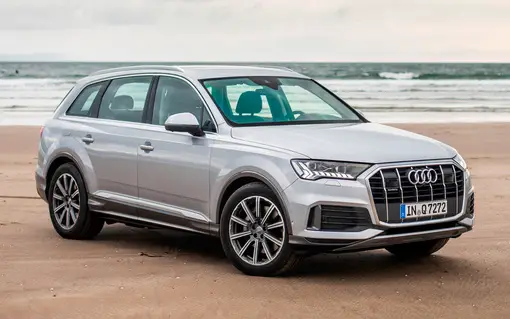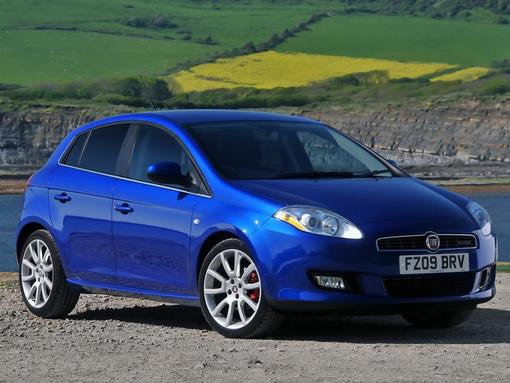6
Hva er Audi Q7 eller Fiat Bravo?
Audi Q7
Fiat Bravo


13 grunner for å kjøpe Audi Q7
-
Mer sylindere
2 sylinder mer. The more cylinders, the greater the engine stability with less vibration. Engine efficiency increases due to shorter pauses between strokes.
6 sylindere 4 sylindere -
Stempelslag lenger
12% eller 10.9 mm The longer the piston stroke, the better the engine’s fuel combustion efficiency. This reduces fuel consumption and creates a more environmentally-friendly engine.
91.4 mm Stempelslag 80.5 mm Stempelslag -
Mer sylinderboring
4% eller 3.5 mm The larger the cylinder bore, the better the combustion chamber fills. This provides power but can also increase engine emissions.
83 mm sylinderboring 79.5 mm sylinderboring -
Mer motorkraft
58% eller 166 hk The greater the vehicle's power, the better the acceleration. Also, powerful cars provide higher speeds.
286 hk motorkraft 120 hk motorkraft -
Mer dreiemoment
50% eller 300 Nm. The higher the torque, the faster the acceleration.
600 Nm @ 2250-3250 rot/min. dreiemoment 300 Nm @ 1500 rot/min. dreiemoment -
Mer toppfart
46 km/h The higher the top speed, the faster the car travels on the highway.
241 km/h toppfart 195 km/h toppfart -
Mer motor kapasitet
46% eller 1369 cm3 mer. The greater the engine capacity, the lower the wear and tear. Larger engine capacities provide longer vehicle lifespans.
2967 cm3 motor kapasitet 1598 cm3 motor kapasitet -
Raskere akselerasjon fra 0 til 100 kmt
62% eller 4 sek The faster the acceleration, the faster the driver can reach optimal speed, though this can contribute to greater fuel consumption.
6.5 sek akselerasjon fra 0 til 100 kmt 10.5 sek akselerasjon fra 0 til 100 kmt -
Mer drivstofftankens kapasitet
24% eller 18 l The greater the fuel tank capacity, the further the vehicle can travel without refueling.
75 l drivstofftankens kapasitet 57 l drivstofftankens kapasitet -
Ovenfor europeisk utslippsstandard
1 generasjon The higher the environmental standards of the vehicle, the less CO2 and other emissions it produces when driving, which reduces harmful effects on the environment.
Euro 6d-TEMP-EVAP-IS europeisk utslippsstandard Euro 5 europeisk utslippsstandard -
Mer minimum bagasjerom kapasitet
54% eller 465 l The lower the trunk capacity, the fewer items a driver can store in the vehicle without lowering the rear seats.
865 l minimum bagasjerom kapasitet 400 l minimum bagasjerom kapasitet -
Mer maksimal bagasjerom kapasitet
43% eller 875 l The greater the trunk capacity, the more items a driver can store in the vehicle without lowering the rear seats.
2050 l maksimal bagasjerom kapasitet 1175 l maksimal bagasjerom kapasitet -
Mer maks tauevekt med bremser
52% eller 1400 kg The greater the permitted trailer load with brakes, the more the vehicle can tow larger and heavier trailers without damaging the engine.
2700 kg maks tauevekt med bremser 1300 kg maks tauevekt med bremser
9 grunner for å kjøpe Fiat Bravo
-
Det er bedre kompresjon
3% eller 0.5 The higher the compression ratio, the less fuel is required to achieve the same power. This can affect the engine's efficiency.
16 kompresjon 16.5 kompresjon -
Mindre drivstofforbruk (kombinert syklus)
26% eller 1.7 l/100 The lower the fuel consumption, the lower the exhaust emitted into the air. Economical cars are also more efficient to drive.
6.6-6.8 l/100 km drivstofforbruk (kombinert syklus) 4.9 l/100 km drivstofforbruk (kombinert syklus) -
Mindre drivstofforbruk (motorvei)
35% eller 2.2 l/100 The lower the fuel consumption, the lower the pollution-causing emissions. Also, drivers save money by using an economical car.
6.3-6.4 l/100 km drivstofforbruk (motorvei) 4.1 l/100 km drivstofforbruk (motorvei) -
Mindre drivstofforbruk (byen)
13% eller 0.9 l/100 The lower the fuel consumption, the more economical it is to drive the vehicle. Also, economical cars are more environmentally-friendly.
7.2-7.3 l/100 km drivstofforbruk (byen) 6.3 l/100 km drivstofforbruk (byen) -
Mindre Co2 utslipp
35% eller 45 g/mil The less CO2 emission the vehicle releases, the less damage to the environment it causes.
174 g/mil (280 g/mile) Co2 utslipp 129 g/mil (208 g/mile) Co2 utslipp -
Mindre hC
50% eller 250 kg
750 kg hC 500 kg hC -
Mindre vekt
64% eller 845 kg. Weight of the vehicle affects: fuel consumption, acceleration dynamic, braking distance, etc.
2165 kg vekt 1320 kg vekt -
Mindre svingradius
20% eller 2.1 m The shorter the turning cycle, the less space is required for the vehicle to turn around. This improves the vehicle’s agility.
12.5 m svingradius 10.4 m svingradius -
Kortere hjulbase
15% eller 394 mm The shorter the wheelbase, the better the vehicle’s cross-country driving range. Also, shorter wheel-based cars are easier to steer out of a skid.
2994 mm hjulbase 2600 mm hjulbase
Neutrale grunner Audi Q7 og Fiat Bravo
-
Motor posisjon
Front, langsgående Motor posisjon Foran, tverrgående Motor posisjon -
Sylinderes plassering
V Motor Sylinderes plassering På linje Sylinderes plassering -
Drivstofftilførsel
Diesel Commonrail Diesel Commonrail -
Maksimalt tillatt vekt
Audi Q7 1185 kg tyngre.
3015 kg Maksimalt tillatt vekt 1830 kg Maksimalt tillatt vekt -
Dører
5 Dører 5 Dører -
Lengde
Audi Q7 727 mm mer.
5063 mm Lengde 4336 mm Lengde -
Bredde
Audi Q7 178 mm bredere.
1970 mm Bredde 1792 mm Bredde -
Høyde
Audi Q7 243 mm ovenfor.
1741 mm Høyde 1498 mm Høyde -
Forhjul størrelse
255/ 60 R18 108Y; 255/55 R19 Forhjul størrelse 205/55 R16 Forhjul størrelse -
Fremre spor
1679 mm Fremre spor 1538 mm Fremre spor -
Bakre spor
1691 mm Bakre spor 1532 mm Bakre spor
Motor og Girkasse
Sylindere
Sylindere
4
Ventiler per sylinder
4
Ventiler per sylinder
4
Kompresjon
16
Kompresjon
16.5
Stempelslag
91.4 mm
Stempelslag
80.5 mm
Motor posisjon
Front, langsgående
Motor posisjon
Foran, tverrgående
Sylinderes plassering
V Motor
Sylinderes plassering
På linje
Sylinderboring
83 mm
Sylinderboring
79.5 mm
Ytelse
Motorkraft
286 hk @ 3500-4000 rot/min.
Motorkraft
120 hk @ 4000 rot/min.
Dreiemoment
600 Nm @ 2250-3250 rot/min.
Dreiemoment
300 Nm @ 1500 rot/min.
Akselerasjon fra 0 til 60 mph
6.2 sek
Akselerasjon fra 0 til 60 mph
10 sek
Toppfart
241 km/h
Toppfart
195 km/h
Motor kapasitet
2967 cm3
Motor kapasitet
1598 cm3
Akselerasjon fra 0 til 100 kmt
6.5 sek
Akselerasjon fra 0 til 100 kmt
10.5 sek
Drivstofforbruk
Drivstofforbruk (kombinert syklus)
6.6-6.8 l/100 km
Drivstofforbruk (kombinert syklus)
4.9 l/100 km
Drivstofforbruk (motorvei)
6.3-6.4 l/100 km
Drivstofforbruk (motorvei)
4.1 l/100 km
Drivstofforbruk (byen)
7.2-7.3 l/100 km
Drivstofforbruk (byen)
6.3 l/100 km
drivstofftankens kapasitet
75 l
drivstofftankens kapasitet
57 l
Drivstofftilførsel
Diesel Commonrail
Drivstofftilførsel
Diesel Commonrail
Utslipp
Co2 utslipp
174 g/mil (280 g/mile)
Co2 utslipp
129 g/mil (208 g/mile)
Europeisk utslippsstandard
Euro 6d-TEMP-EVAP-IS
Europeisk utslippsstandard
Euro 5
HC
750 kg
HC
500 kg
Vekt og kapasitet
Minimum bagasjerom kapasitet
865 l
Minimum bagasjerom kapasitet
400 l
maksimal bagasjerom kapasitet
2050 l
maksimal bagasjerom kapasitet
1175 l
Maksimalt tillatt vekt
3015 kg
Maksimalt tillatt vekt
1830 kg
Maskimal tauevekt uten bremster
750 kg
Maskimal tauevekt uten bremster
500 kg
Maks tauevekt med bremser
2700 kg
Maks tauevekt med bremser
1300 kg
Vekt
2165 kg
Vekt
1320 kg
Seter
5
Seter
5
Andre spesifikasjoner
Svingradius
12.5 m
Svingradius
10.4 m
Dører
5
Dører
5
Dimensjoner
Lengde
5063 mm
Lengde
4336 mm
Bredde
1970 mm
Bredde
1792 mm
Høyde
1741 mm
Høyde
1498 mm
Hjulbase
2994 mm
Hjulbase
2600 mm
Hjul og dekk
Forhjul størrelse
255/ 60 R18 108Y; 255/55 R19
Forhjul størrelse
205/55 R16
Fremre spor
1679 mm
Fremre spor
1538 mm
Bakre spor
1691 mm
Bakre spor
1532 mm
Lignende sammenligninger:
| Audi Q7 og Jaguar XJ | Fiat Bravo og Ford Fiesta |
| Audi Q7 og Audi Quattro | Audi Q7 og SEAT Altea |
| Fiat Bravo og Fiat Qubo | Audi Q7 og Nissan Juke |


